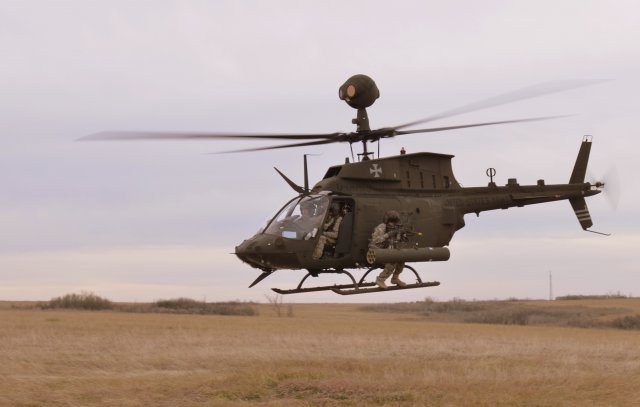Aviators from the 1st Combat Aviation Brigade, 1st Infantry Division, tested a new self-extraction training scenario designed to save lives in the most dire of circumstances during a survival and evasion exercise in mid-November.
“This is a non-standard event,” explained Capt. Tony Snipes, commander of Troop C, 1st Squadron, 6th Cavalry Regiment. “There is no Army standard, so we are trying to standardize it and execute it as professionally as possible.”
The scenario placed the aviation Soldiers in a simulated hostile environment where they were required to make their way from a “downed” OH-58D Kiowa Warrior helicopter to a designated pick-up zone more than a kilometer away. Once at the pickup zone, the stranded aviators were rescued by their fellow Kiowa pilots. Since the Kiowa is such a small aircraft, the rescued Soldiers had to secure themselves to the outside of the aircraft using straps connected to their flight gear.
The self-extraction technique was used in Iraq in 2004 during the rescue of downed OH-58D Kiowa Warrior pilots Chief Warrant Officer 2 Chad Beck and Chief Warrant Officer 2 Greg Crow. It was used again in Iraq in 2007 following the downing of an aircraft piloted by Chief Warrant Officer 2 Mark Burrows and Chief Warrant Officer Steven Cianfrini. In both instances, the rescued pilots rode outside of an AH-64 Apache secured by a nylon strap attached to the pilots’ vests.
“Pilots have to respond immediately and have to be extracted immediately,” said Lt. Col. Paul Cravey, 1st Sqdn., 6th Cav. Regt. commander. “Most of the shoot-down or forced-landing situations we (encounter) don’t drag out for several days. The action usually goes down within an hour.”
A Defense.gov news article dated Nov. 5, 2004, reported that self-extraction is a maneuver pilots are told about in flight school, but are never given any hands-on, “this-is-how-you-do-it” training. Cravey said his team saw a need to offer a training scenario that would prepare his pilots for the potential need for self-extraction in a combat situation.
During this training “our pilots gain confidence in their equipment, and (have the opportunity to) work on the tactics necessary to extract a fellow crew member from a hostile situation,” the commander said.
Snipes said his team plans to package the new training and share it with the rest of the squadron and, eventually, the rest of the Army.
“This is realistic training that will save lives downrange,” he said.











